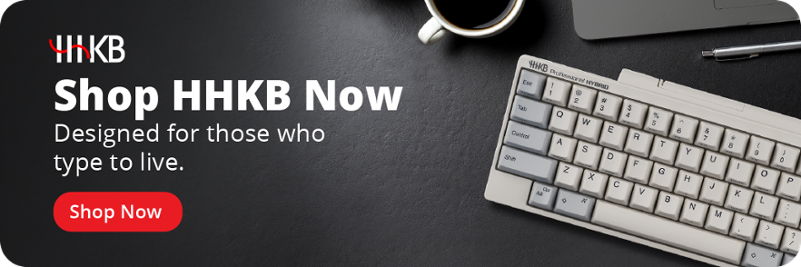From switch style to form factor, find the programming keyboard that suits your needs
The typical programmer spends an inordinate amount of their work life typing away in front of a set of monitors. This aspect of their job makes it incredibly important for them to optimize every facet of their environment: If you’re going to sit in one place for eight hours a day, five (or more!) days a week, you want that spot to be as perfectly suited to your body and work style as much as possible.
This article helps programmers on their journey to the perfect workspace, listing the best coding keyboards by efficiency, ergonomics, and value.
For more expert advice, check out The Ultimate Guide to the Best Keyboards for Programming, a comprehensive resource for programmers or shop mechanical keyboards for programming now.
Jump to a section:
Factors to consider when choosing a coding keyboard
Mechanical vs. membrane switches
Just like gamers and touch typists, many programmers have strong feelings about whether to buy membrane or mechanical keyboards. For a brief summary:
- Membrane keyboards are the “standard” models that you’d find in most offices. These peripherals consist of a single polymer “membrane” with keycaps on top. Pressing down on a keycap sends an electrical signal that your computer recognizes as a keystroke. Membrane keyboards have few moving parts, which makes them quiet and inexpensive. However, they generally don’t last as long as mechanical keyboards. With soft membranes and shallow keycaps, these peripherals also don’t offer much tactile feedback — something many typists value because the physical feel of each keypress can make typing more precise and enjoyable.
- Mechanical keyboards are a common sight in the gaming and keyboard enthusiast spheres. Every single keycap on these keyboards has a dedicated mechanical switch underneath it. These switches contain plastic “stems” and metal springs, which give tactile feedback after every keystroke. Mechanical keyboards tend to be louder than membrane models, as well as more expensive. But they’re also more durable and tend to offer more comfortable (and customizable) typing experiences.
If you want the responsiveness of a mechanical keyboard with the soft, quiet touch of a membrane keyboard, you have options. The innovative Topre switch, for example, fuses both membrane and mechanical elements for a unique feel and satisfying typing experience.
Size options: Full-size, TKL, 60%, and more
Modern keyboards come in a variety of sizes and shapes. Any one of those styles could make a good coding keyboard, depending on your preferences:
- Full-size keyboards are the model you’ll find in most stores and workplaces. They tend to measure about 17 inches across, which means they take up a lot of desk space. On the flip side, you get about 104 keys, including a row of function keys, a dedicated number pad, four arrow keys, and a set of navigation keys (Home, PgUp, PgDn, etc.).
- TKL keyboards drop the numpad, but otherwise contain all the same keys as their full-size counterparts. They have about 87 keys and measure about 14 inches across. Programmers who want arrow and function keys but who don’t need a numpad should look into TKL models.
- 60% keyboards are also called “mini keyboards,” and it’s an apt name. These devices are about 60% as large as a full-size keyboard (thus the name), contain roughly 61 keys, and measure about 12 inches across. These keyboards don’t have function, arrow, navigation, or numpad keys, relying on programmable shortcuts for those features instead. Different manufacturers use different key layouts to ensure easy access to Enter, Delete, Shift, and other vital keys.
You may also come across other styles, such as split keyboards, ergonomic keyboards, or different sizes of compact keyboards (between 65% and 75%). The best keyboard for coding is ultimately whichever one you find most comfortable, so take some time to figure out which keys you use all the time and which you almost never touch. You may also want to measure your desk to see how much space you can spare.
Keyboard layouts: QWERTY and its alternatives
Most keyboards use the QWERTY layout, named for the first row of letters you’ll find in the upper-left. While QWERTY has a venerable history, it’s not the only game in town — and it’s not necessarily an ideal layout for the best coding keyboard. Compare some of the various keyboard layouts:
- QWERTY keyboards are modern incarnations of a 19th-century idea. The QWERTY layout emerged in the 1870s as a way to keep frequently used typewriter keys from jamming. As computer keyboards replaced typewriters, manufacturers kept the familiar design. QWERTY is familiar and ubiquitous, but it’s not especially efficient or comfortable.
- Dvorak keyboards are based on a layout from August Dvorak, a 20th-century American psychologist. Instead of preventing jammed keys, Dvorak optimized his layout around key usage frequency. Dvorak layouts are relatively easy to learn and may reduce wrist strain.
- Colemak keyboards aim to split the difference between QWERTY and Dvorak. Most keys are in familiar QWERTY locations, but frequently used keys such as E, I, N, O, and T are in the middle row rather than the outer ones.
- Workman keyboards may be the best keyboards for coding, according to their creator, programmer OJ Bucao. Having tried both Dvorak and Colemak, he wanted a layout that made it as easy as possible to type common English words. The layout also takes finger strength and length into account.
Since each layout has different strengths and weaknesses, any one of them could work in a coding keyboard. QWERTY is familiar. You’ll find it at every office and library you visit — and on almost every laptop you can buy. The other three have learning curves, which means you may spend months learning them before your typing speed is back up to par. Still, QWERTY wasn’t designed with modern keyboards in mind, and that alone makes the alternatives worth investigating.
Did You Know?:The HHKB Professional Hybrid keyboards come in standard and silent versions, so you can choose the sound profile that works best for you.
Why keyboard programmability matters for coding efficiency
Some high-end keyboards allow you to reprogram keys, either via specialized software or directly through the hardware. Programmability is one of the best features you can have in a coder keyboard. There are three main reasons why:
- Keyboard macros: Creating macros lets you insert large blocks of text or automate repetitive keystrokes with a single button press. You could start coding from a familiar template instantly or add a complicated sequence of operators without any typos.
- Key remapping: Programmability is good to have on any keyboard, but it’s particularly important on mini keyboards. If you don’t have arrows or function keys, you’ll need to remap buttons or set up shortcuts instead. Otherwise, you’ll be reliant on a mouse for navigation, and that’s much slower.
- Custom shortcuts: Programming doesn’t just involve typing. You also have to open apps, clear caches, and find saved files. You may also want to consult video tutorials or play music while you work. Programmable keys let you set up shortcuts for any of these functions.
Our recommendation: HHKB Professional Hybrid Type-S
Try out the HHKB Professional Hybrid Type-S. An industry standout that’s consistently ranked as the best keyboard for coders by experts, this keyboard has the efficiency, ergonomics, and portability that programmers need to do their best work.
Invented by the pioneering computer scientist Dr. Eiiti Wada in 1996, the Happy Hacking Keyboard (or HHKB) was designed to maximize the typing efficiency of coders. One of Wada’s significant innovations was the HHKB’s novel keyboard layout, which rearranges keys (like the control key) so that programmers can keep their fingers on the home row as much as possible — boosting typing speed.
The keyboard face design and switches are two more unique ergonomic features that ensure typing on an HHKB keyboard is super-efficient.
- Keyboard face design: Instead of holding a uniform keycap angle from the top to bottom key rows, the HHKB keyboard’s concave face positions each key at the ideal angle for easy typing, even across extended sessions.
- Unique switches: The keyboard’s exclusive Type-S Topre silent switches significantly reduce keystroke noise. They are also renowned for their comfort (each keypress is incredibly smooth) and accuracy (unlike other keyboards, its keypress detection mechanism is largely separate from resistance provisioning, boosting precision).
The HHKB Professional Hybrid Type-S also includes the extra features enthusiasts look for in top-of-the-line mechanical keyboards like complete keymap customizability and Bluetooth connectivity. And, being both compact and lightweight, the keyboard is highly portable.
The HHKB Professional Hybrid Type-S is one of the best coding keyboards, especially for programmers who want the most efficient and smooth typing experience possible. Click here to get a close look at this or any of our other incredible keyboards.
Note: Information and external links are provided for your convenience and for educational purposes only, and shall not be construed, or relied upon, as legal or financial advice. PFU America, Inc. makes no representations about the contents, features, or specifications on such third-party sites, software, and/or offerings (collectively “Third-Party Offerings”) and shall not be responsible for any loss or damage that may arise from your use of such Third-Party Offerings. Please consult with a licensed professional regarding your specific situation as regulations may be subject to change.







